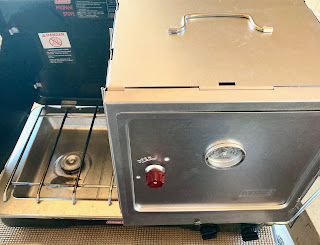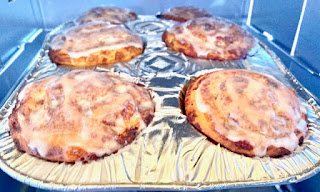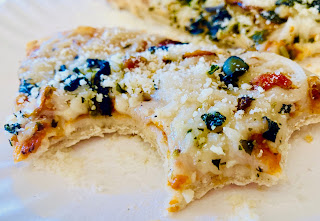Who knew a Coleman Camp Oven could prove to be an essential baking tool at home? When I purchased this oven for a camping trip, it never once crossed my mind that I would find myself thankful for its use during an extended power outage at my primary residence. I have actually used it more at home during the pandemic than I would ever have imagined.
Deliciousness! That is the word I associate with my little camping bakery. Imagine waking up to the irresistible aroma of fresh-out-of-the oven hot cinnamon rolls. Oh my yes! One might even make up an excuse for a staycation if this is how we roll.
And that's only the start of the day. How about some homemade pizza for lunch? Such a breeze to bake in your Coleman oven. I found it best to bake the pizza on the top rack in the oven, though some cooks use a pizza stone on the bottom rack with very good results.
Getting back to the oven itself, let's take a look at a few of the great features, along with more baking tips. When first unboxing the oven, I was pretty surprised at how compact it folds up for storage and travel. Very impressive design. It takes up almost no room in the Rubbermaid tote I use for organizing my camping kitchen gear. Included in the box: Coleman Camp Oven, two baking racks, and instructions.
The oven sits over the top of a burner on my Coleman propane stove. To bake with the oven, you do need the stove and a full one-pound bottle of propane. I made the mistake of starting a pan of muffins with a partially empty propane canister attached to the stove. The propane ran out before the muffins had finished baking. Lesson learned.
You will note the heat indicator gauge on the front door of the camp oven. I keep an eye on the temperature as the oven initially preheats and also while my food is cooking. It only takes about a minute for each 100 degrees of heat gain. Amazing!
That said, the most important thing I have learned about baking temperatures with my Coleman oven is to bake things at a lower temp than what is recommended on the recipe or package. I get perfect muffins and cinnamon rolls when I bake them 100 degrees below the temperature I would use in a regular home oven (250 degrees instead of 350 degrees). They bake for about the same length of time.
Finally, it is important to use this camp oven out of the wind. If you are cooking outdoors on a windy day, or a chilly day, a windbreak makes a huge difference. Some owners of this oven cover it with a small welding blanket to help conserve heat when cooking outside in conditions that would make the oven work harder and longer. They do this because the oven has vent slots where heat can escape. I haven't tried this, but I appreciate the tip, and could see myself making use of this idea.







































